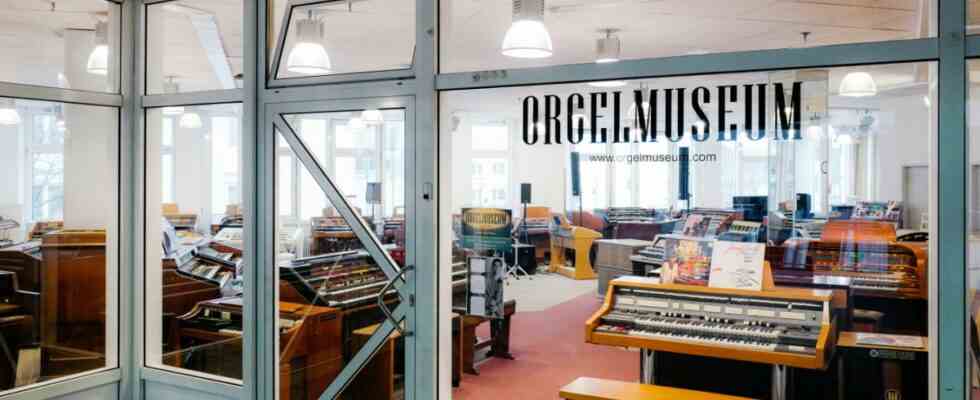There is an apocalyptic atmosphere in the Isar-Amper-Zentrum (IAZ) in Unterschleißheim: Almost all the shop areas are empty, the glass roof has not been cleaned for a long time due to the thick layer of dirt, there are a few buckets on the floor to catch the water dripping from the ceiling. The impending demolition of the IAZ can be clearly felt. The dilapidated shopping center is to make way for a new city center. One remaining tenant clearly stands out: Alois Piterna with his organ museum, whose 280 square meter, brightly lit room on the upper floor of the IAZ radiates much-needed warmth.
Alois Paterna doesn’t let the situation spoil his good mood.
(Photo: Alessandra Schellnegger)
There is little sign of the imminent departure of the museum. Piterna was terminated at the end of the month. But the spacious room still invites you to explore. Closely lined up are electronic organs of different sizes and shapes. Some are clad in glossy wood, others in cream or black plastic, the buttons and shifters come in all sorts of colors. Right in the middle stands the owner Piterna, bubbling with enthusiasm, although he has not yet found an affordable and sufficiently large room for his 160 organs and keyboards. “I’m sure I’ll find something,” he says with conviction.
The oldest pieces in the collection date from the 1970s.
(Photo: Alessandra Schellnegger)
The term “museum” could give the wrong impression that the instruments are presented as exhibits sealed off by glass windows. That’s not the case. It is a place to touch and make music. Each of the electronic organs is functional and can be played. Piterna taught here and held concerts to fund the museum’s expenses. He never asked for admission. His considerable collection includes electronic organs, mainly from Japan, the USA and Europe. The oldest are from the 1970s.
The organs come in all shapes and colors.
(Photo: Alessandra Schellnegger)
A diverse audience visited the organ museum. Some of them were interested people from Unterschleißheim and the region, some like-minded organ lovers from all over the world. Many came because of nostalgia or because they were interested in the technical structure of the instruments, says Piterna. Some organs from the 1980s consist of more than 200,000 components. When you open the cover of a neat-looking electronic organ, you are greeted by a tangle of cables beyond compare. Countless strands wind their way through the interior from one circuit board to the next. Piterna estimates the total weight of his collection at 30 tons.
“I’ve never had so much support”
Piterna has been fascinated by the instrument for several decades. Born in Erdinger, he began training as an organist at the age of 20. He bought his first organ in 1973. He performed as an organist with various bands, made contacts with the manufacturers, attended trade fairs and thus acquired his extensive expertise. After a variety of years in which he commuted between Hanover, Zurich and London, he settled down in Unterschleißheim. Here he headed the music school for 40 years until 2020 and opened the organ museum in 2003. Now the 69-year-old enjoys concentrating on his passion: “No more administration, just lessons and concerts.”
For Piterna, the termination of the rented space around the turn of the year came as no surprise. When he moved into the premises in the IAZ in mid-2017, he already knew that the days of the shopping center built in the 1980s were numbered. For many, the empty department store is a sad example of the desertification of German inner cities. The investment company Rock Capital, on the other hand, saw untapped potential in the center of Unterschleißheim. Since 2015, the Grünwald-based company has gradually bought up the retail space until it owns all the shares. The long-term plan is to fundamentally redesign the city center. By 2033, new residential complexes and rooms for retail and gastronomy are to be built. There will be no more room here for Piterna’s organ museum. Although the IAZ is not scheduled to be demolished until 2025, the remaining tenants will have to move out at the end of February in order to save the costs of maintaining the building for two more years.
Since then, the musician has managed to reduce the collection from 440 pieces to 140 organs and 20 keyboards in order to make the excerpt less complicated. He hopes to be able to donate part of the collection to the Deutsches Museum. He could imagine designing his exhibition differently in the future. A possible option would be to only show a small selection of instruments and to store the majority in a depot. Overall he is confident. “I’ve never had so much support,” he says. As a farewell, Piterna is planning a final open day from 4 p.m. to 6 p.m. on Monday, February 27.

